Filippa Dobson
- Position
- LAHRI Postdoctoral Research Fellow (November 2021-April 2022)
- Areas of expertise
- Practice-based and practice-led research in cross-disciplinary arts and creative industries, oral history, mythology, folklore and anecdotal evidence (migrants, travellers and agricultural labourers), creative writing, gift exchange and time-based economic models of production, posthumanism and the supranatural.
- Location
- Clothworkers South Building
- Faculty
- Arts Humanities and Cultures
- School
- Leeds Arts and Humanities Research Institute
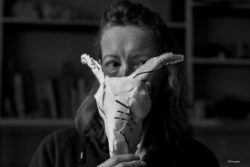
Filippa Dobson by Chandra Prasad, with permission. This image formed part of an exhibition around "hidden disabilities" for Care International at Artspace, Bristol, October 2021
I am a prize-winning artist and an academic researcher.
Between 2012 and 2018, my practice-based research Barren (Yeld): (Traces of Ain) Landscape, Postcolonialism and Identity argued for a more nuanced entanglement of the human with the non-human animal and more-than-human environment. My thesis detailed the productive and, by extension, "naturecultural" relationship between the author and the Badger Stone, a Neolithic "cup marked" monument and glacial erratic on Ilkley Moor, UK. Rock art can be interpreted as a signage system that extends across Europe and as far north as Orkney and Shetland: cup marks appear in landscape settings, stone circles, burial cairns and cists and as portable or "mobiliary" art forms.
The three key aims of my practice-based research related to geographical boundaries, the structuring of identity and cultural resistance to issues of power and control. My research signified a change in emphasis from a definition of postcolonialism as necessarily boundaried and territorial towards a potential new understanding as a political tactic of resistance to land issues and "heritage control". My term "heritage control" is a strategy for land management and access to scheduled monuments. Primary themes of walking, collecting, mapping and printmaking were catalysts into performance and land art. By intertwining practice with different theoretical ideas, a "bricolage" methodology emerged whereby actions and print forms became "naturecultural" objects situated on the moor. Situated between physical artefact and ephemeral performance, the afterlife of the actions as imagery, film and text became more than documentation as original artworks and immersive exhibitions. In The Lying Stanes wind, snow and shutter speed conspired to change transitory printed paper into "marked rocks".
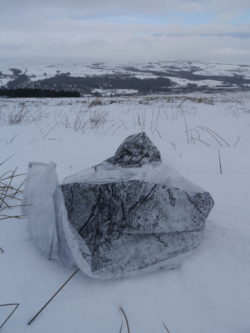
Filippa Dobson. The Lying Stanes. 2015. Ilkley Moor, UK (shortlisted for International Neo: Art Prize)
The combination of performance with mapping principles formed the potentially original contribution to knowledge that the thesis attempted to outline. My final piece, The First Cut, was a land art response to the positive and negative impact of wildfire, which saw the artist and head gamekeeper, Simon Nelson, create a cup and ring mark into the heather using a tractor and flail mower.
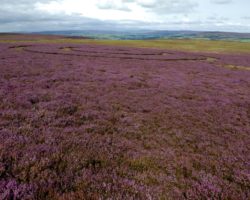
Filippa Dobson. The First Cut. 2016. Ilkley Moor, West Yorkshire, UK.
The artist worked collaboratively with the land: the Bingley Moor Partnership, Natural England, Bradford MDC, the Ilkley Literature Festival, Ilkley Arts, the Leeds Creative Timebank and local archaeologists, Dr Keith Boughey, Richard Stroud and Gavin Edwards (CSI: Ilkley Moor project). The piece entered folklore as "alien art" when the local press picked up drone footage and asked whether the work was extraterrestrial, alien or "man-made"? The artist was a woman. In a parallel universe, a different lens captures a different dimension of the 'happening'.
While previous research employed "reading" methods determined by engagement with landscape, my current research entitled Taciturn Cave (2018 – present), High Pasture Cave, Strath Stuardal, Isle of Skye, Scotland, proposes one defined by excavation. My practice-led research emerges from an experimental methodology, intertwining practice with theoretical ideas from art, archaeology, folklore and feminist philosophy. by reclaiming and transforming another cup-marked monument, a cave and its artefacts, into hybrid repositories of knowledge. I am developing signification ideas as micropolitical action, raising issues of language, representation and gendered in-equalities by adopting a non-discursive "language" of cup marks to make contemporary artworks. I continue to be inspired by feminist, posthumanist, and scientific philosophers, including Donna Haraway, Jane Bennett and Karen Barad, whilst new research increasingly reflects "gender" and "sound" archaeology, including Marie Louise Stig Sørensen, Marta Cintas-Peña, Timothy Darvill and Geoffrey Wainwright. Artists and archaeologists share a methodology of assemblaging informed by examinations of "vibrant materiality" within historical worlds and belief systems. Three field trips to the cave in 2018, 19, and 21, with archaeological excavation director Martin Wildgoose, revealed how trauma manifested itself in the "lockdown" world of the cave (correlated with the Sars-Cov-19 lockdown world) and considered how prehistoric climate change impacted past and present migration pathways.
It was impossible to enter the cave in 2020 because of Covid restrictions and localised flooding. I presented practice-based research relating to my underground explorations at the ASLE-UKI Biennial Conference "Co-emergence, Co-creation, Co-existence" University of Plymouth, 2019, the ASLE-UKI postgraduate conference "Out of the Blue", University of Sheffield, 2-4 September 2020, LAND2 – Members' and Associates' Day, School of Design, University of Leeds, 14 Feb 2020, the Earth(ly) Matters conference: Human in Context: Mind, Body, Nature, & Society, University of Sheffield, 6, 13, 20 August 2021, The Demarco Archive, Summerhall Arts Complex, 13 Nov 2021.
In 2021, listening to sound fragments from a multi-directional stream of cave water gave a "voice" to Bennett's "thing-power".
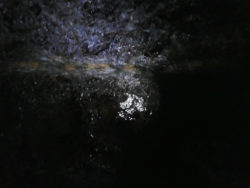
Filippa Dobson. Taciturn Cave. (Cave water dripping on limestone). Isle of Skye, Scotland, UK, 3 Sept 2021,
It began to move my practice into listening and recording audible sound and collaboration with early music specialist Martin Chadwick. Repositioning past and present journeying and migration pathways between mainland UK (and Europe) and the Isle of Skye seeks to represent prehistoric women as nomads and actants within the context of archaeological interpretation and mythological storytelling. What do a goddess and a giant's wife tell us about prehistoric rituals in two site-specific locations? The excavation director found two putative cup-marked mobiliary artefacts on a "shelf" underground. Recently, I discovered upwards of twelve cup-marked portable stones in a burial cairn on Ilkley Moor.
What is the link between the two places, one above and one below ground? One intriguing possibility is that the cave was a site of goddess worship. Were the stones a gift to "Brigid", a Celtic deity? A "giant's wife" dropped stones from her apron in the second location. What role did women play in ritual and memory? One key objective is to reinterpret the power and agency conveyed by portable "things" between places. By exchanging simulations (making, carrying, voyaging and replacing), cup-marked artefacts between the two locations with a view to experiential replication and deposition. Weaving together strands of experiential practice, folkloric interpretation, place names, oral history with the musicality of water on stone extends my dialogic research between the two locations.
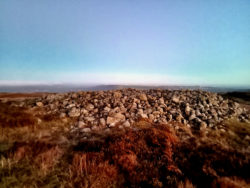
Little Skirtful of Stones, Ilkley Moor, West Yorkshire, UK, 17 Jan 2022
I plan another field trip to the underground chamber in March 2022 to record video with binaural sound, a recording of a discussion with the director, and a presentation of my preliminary findings and conversation at the Bridge Art Collective, Skye and Kyle of Lochalsh, North-West Scotland.
Current Research
I am presenting papers at the University of Leeds, Faculty of Arts Cultures and Humanities, School of Design, Practice as Research seminar, 9 Feb 2022. Proposed conference papers include Nordic TAG April 2022 and ASLE-UKI Biennial conference Epochs, Ages, and Cycles: Time and the Environment 6–8 September 2022. An article is in progress to CePRA Journal, the online journal for practice research published by the University of Leeds, UK. I am invited to write an essay for the Time & Mind peer-reviewed journal about Talking Stone, a night-time hike and projection onto the Badger Stone, presenting a new perspective on a landscape monument as community public art. Previously, I was invited to present papers at archaeology conferences, including British Rock Art Group (BRAG), 2018 and the Theoretical Archaeology Group (TAG), 2015 and 2016. You can find selective conference papers here.
Exhibitions
I have exhibited my artwork, performance, photography and film work widely in the UK. A selection follows: Here be Wales. Hull Maritime Museum, 5 Feb – 22 Apr 2019, The First Cut, Kilmartin Museum, Argyll, Scotland, 14 Mar 2018, Talking Stone: Finding Meaning in the Landscape of Ilkley Moor, Ilkley Manor House (formerly Bradford Metropolitan District Council (MDC) Museum), 2018. I was a member of the organising committee for In the Open: an exhibition of collaborative artworks around the place, landscape and environment, curated by Judith Tucker. Sheffield, 2017, Talking Stone, a mapping projection and night hike, Ilkley Moor, 2015. Yeld: Vernon Street Gallery and Leeds Arts University, 2015. PAGES: Leeds International Artist Book Fair, University of Leeds, 2010-2020.
Prizes
My art prizes include "Tour de Yorkshire: Best Dressed Host Location" Ilkley, Cow and Calf Rocks (artwork suspended from the rock face) 4-5 May 2018, shortlisted for International Neo: Art Prize, 2015, shortlisted for Sheffield International Artist's Book Prize, 2011, shortlisted for the Henry Moore Institute Dissertation Prize 2010, winner Photography Category, Northern Design Competition 2010, shortlisted for Art in the Park, Bradford MDC, 2009, shortlisted for Fine Art Category, Northern Design Competition, 2009, winner Bradford "Open" Bradford MDC 2007.
Professional affiliations
Member of ASLE – UKI, the Association for the Study of Literature and Environment, UK and Ireland.
Associate member of LAND2, the creative practice-led research network LAND2, "land squared" started in 2002 by Iain Biggs (UWE Bristol), Judith Tucker (Leeds) and Mary Modeen (Dundee) as a national network of artists and researchers interested in landscape/place-oriented art practice.
Member of Leeds Creative Timebank facilitating time-based payments for artists and creatives.
Publications
Dobson, Filippa Jane (2018) Barren (Yeld): (Traces of Ain) Landscape, Postcolonialism and Identity.
Qualifications
PhD Fine Art 2018, University of Leeds
BA Hons. Fine Art first class 2010, University of the Arts, Leeds
HE cert. Contemporary Design 2006, Leeds Beckett University
Dip Lib (MA in Library and Information Science), London Guildhall University, BA Hons. (Combined honours in Literature and Ecology (human and marine), University of Stirling
